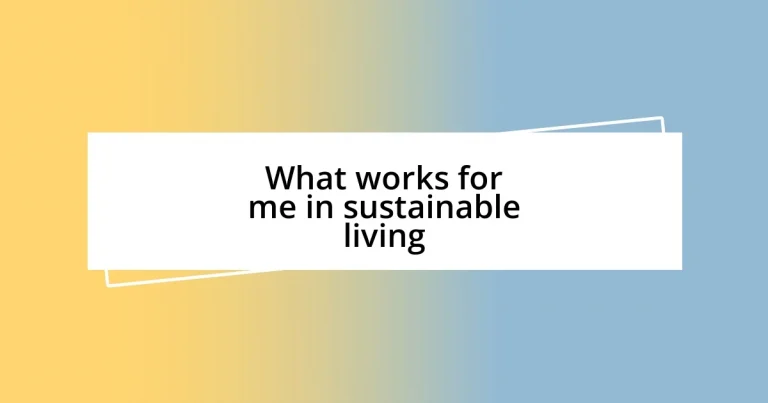Key takeaways:
- Adopting sustainable living principles includes reducing consumption, regenerating resources, and choosing mindful products, fostering both personal well-being and environmental health.
- Regular assessments of environmental impact, such as keeping a journal and conducting eco-audits, help track habits and motivate better choices, ultimately minimizing waste and carbon footprints.
- Building community through initiatives like gardening and sustainability fairs enhances connections and encourages collective efforts toward a greener future, proving that shared values drive sustainable change.
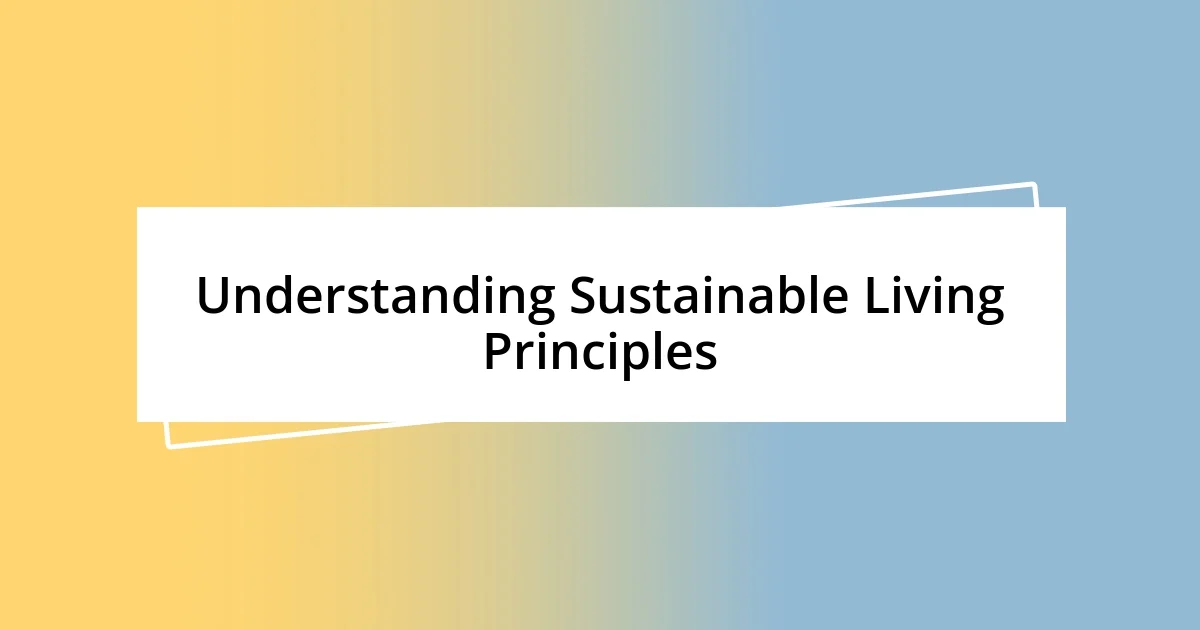
Understanding Sustainable Living Principles
Sustainable living is fundamentally about making choices that honor the planet’s ecosystems while also supporting our own well-being. I remember the first time I switched to a plant-based diet, driven by both health concerns and a desire to reduce my carbon footprint. It felt rewarding to know that each meal I prepared was contributing to a larger goal of sustainability.
One key principle is the idea of reducing consumption—less is truly more. I often ask myself: “Do I really need this item?” This question has led me to minimize clutter and honestly appreciate what I already own, creating a more peaceful environment at home. It’s surprising how much lighter I feel after letting go of things that no longer serve me.
I also believe in the principle of regeneration, which urges us to restore and replenish resources rather than deplete them. A community garden I participate in has not only helped me learn about local flora but also fostered connections with neighbors all dedicated to nurturing our shared environment. Isn’t it incredible how sustainable practices can create not just healthier ecosystems, but also stronger communities?
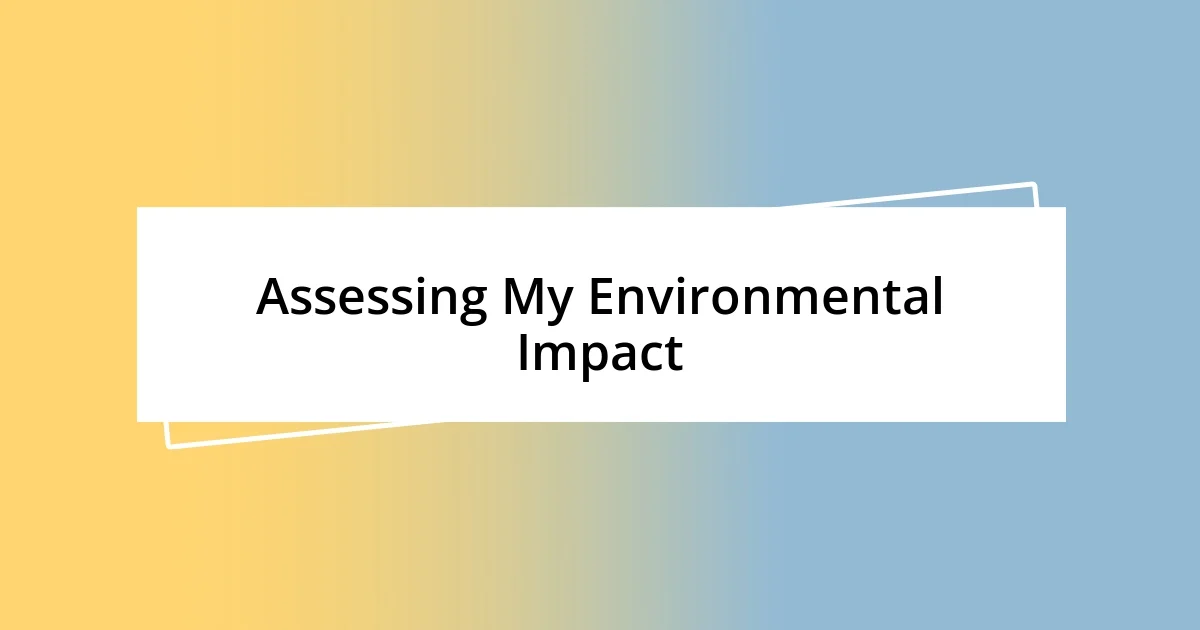
Assessing My Environmental Impact
Assessing my environmental impact is a continuous and reflective process. I’ve found that keeping a personal journal helps me track my actions, like my energy use or waste generation, and truly understand how my choices affect the planet. For instance, I recently recorded my monthly energy consumption and was surprised at how certain habits, like leaving lights on unnecessarily, could be easily corrected with mindful changes.
To gauge my environmental footprint more comprehensively, I often compare my habits to established guidelines. It’s fascinating to see where I stand in relation to the average individual. For example, using public transportation not only reduces my carbon output but also inspired a deeper appreciation for community interactions. Each bus ride is more than just a mode of transport; it’s a chance to connect with the rhythm of my neighborhood.
I’ve also embraced the practice of conducting an annual eco-audit of my lifestyle. This involves assessing my waste, energy use, and even my water consumption. By setting tangible goals, I’ve gradually minimized my plastic use and enhanced my recycling habits. Embracing these regular assessments has become a source of motivation, pushing me towards more sustainable choices each year.
| Action | Impact |
|---|---|
| Reduce Plastic Use | Minimized waste going to landfills |
| Use Public Transport | Lowered carbon emissions |
| Conduct Eco-Audits | Improved awareness and choices |
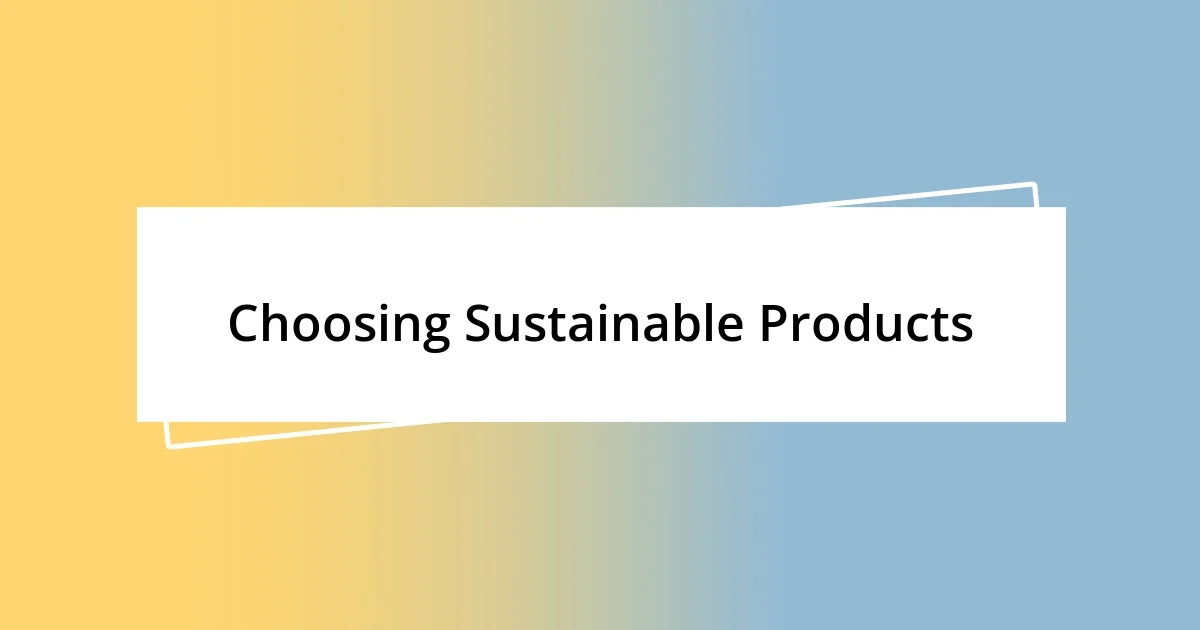
Choosing Sustainable Products
Choosing sustainable products is an essential aspect of living mindfully. Whenever I find myself in a store, I pause and consider the lifecycle of the items I’m about to purchase. I often recall a time when I made the mistake of buying so-called eco-friendly cleaning supplies, only to discover they were packaged in single-use plastic. That realization hit hard; it’s not just about the product itself but also how it affects our planet.
When selecting sustainable products, I always focus on a few key aspects:
- Materials: I opt for organic or upcycled materials, which help reduce waste and use fewer resources.
- Packaging: I look for products with minimal or recyclable packaging—this simple change drastically cuts down on pollution.
- Local Sources: Supporting local producers not only benefits my community but often means fresher, less processed goods.
- Transparency: I appreciate brands that are open about their sourcing and production practices; it builds trust and accountability.
Each choice I make reinforces my commitment to sustainability, reminding me of how interconnected our actions are and their impact on future generations. It feels empowering to be part of this shift towards more thoughtful consumption.
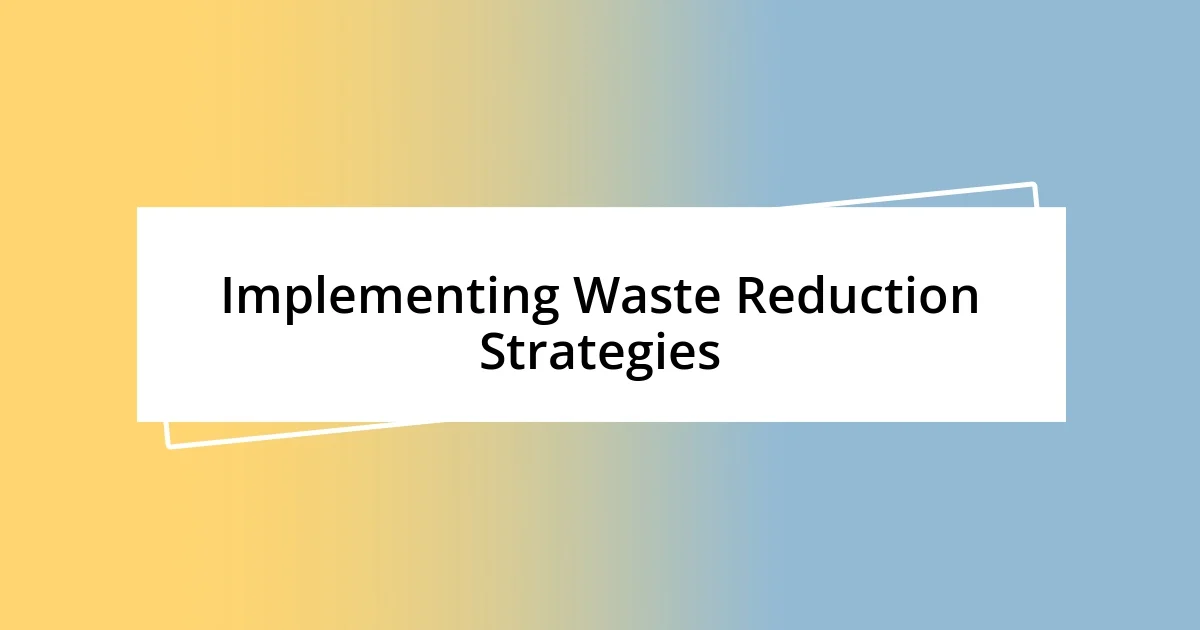
Implementing Waste Reduction Strategies
When it comes to reducing waste, I’ve found that small, consistent changes can lead to significant results. For example, I started carrying a reusable shopping bag everywhere I go. The first time I forgot to grab it and had to use a plastic bag, it made me feel guilty. Now, I can’t imagine shopping without my sturdy tote—it’s become a part of my routine. Have you tried that? You might find it liberating to break the habit of grabbing single-use bags.
Another waste reduction strategy I’ve embraced is composting kitchen scraps. Initially, I was hesitant because it seemed messy and complicated. However, after watching a few online tutorials, I realized how simple it is. Now, instead of tossing vegetable peels and leftover food, I place them in my compost bin. It’s rewarding to see how quickly it breaks down, transforming into rich soil for my plants. Plus, I feel a sense of accomplishment each time I turn waste into something beneficial. Have you ever considered composting? It can really change your perspective on food waste.
Lastly, I make a conscious effort to refuse single-use items whenever possible. Whether it’s saying no to plastic straws with my drink or bringing my own coffee cup to cafes, these choices really add up. I’ll never forget the time I attended a party and saw how many disposable plates and cups were used. It was a wake-up call. Since then, I’ve made it my mission to encourage friends to use more sustainable alternatives. The conversations can spark motivation in others, and you might find that it turns into a collective effort to reduce waste! Why not take that step with your friends or family, too? It’s often easier—and more fun—when you share the journey with others.
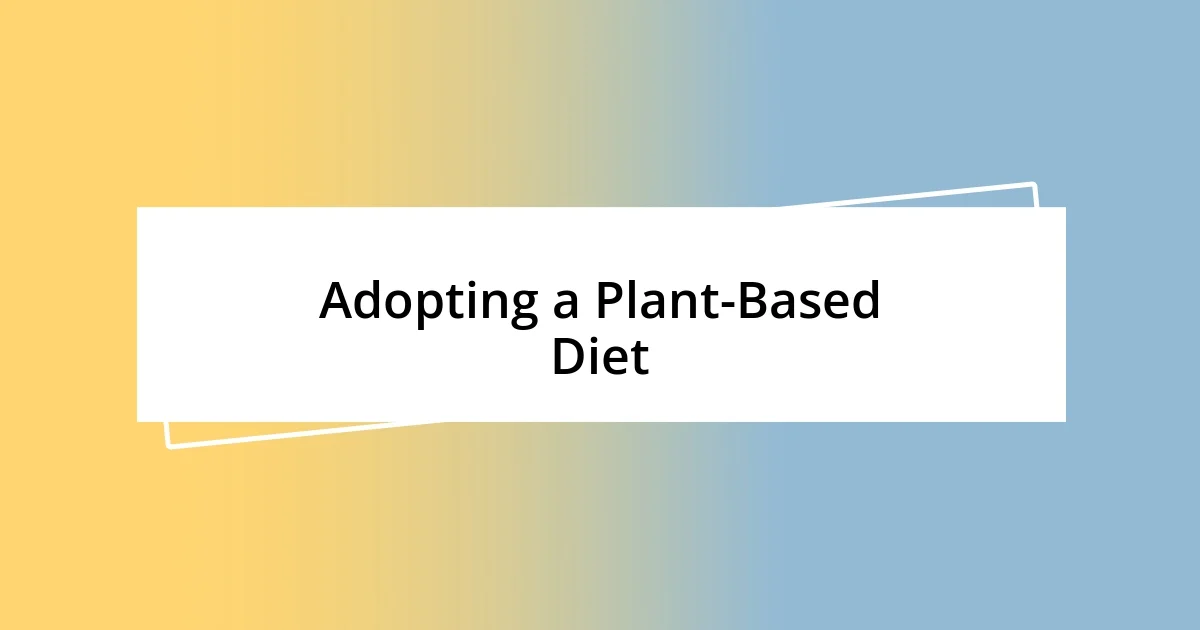
Adopting a Plant-Based Diet
Adopting a plant-based diet has been a transformative journey for me. I remember the first time I prepared a colorful vegetable stir-fry; the vibrant veggies practically leaped off the plate! The experience shifted my perspective on food and really opened my eyes to the flavors and nutrients plant-based meals offer. Have you ever felt a mistake spark a new passion? For me, it was stumbling upon a documentary that revealed the environmental impact of animal agriculture. That moment ignited my curiosity and determination to experiment with my food choices.
I’ve found that incorporating more plant-based meals not only benefits my health, but also my relationship with the environment. For instance, I started to notice how much better I felt after swapping out heavy meat dishes for lentil soups and quinoa salads. These meals are not just nutritious; they’re also delightfully satisfying! Every time I share a plant-based recipe with friends and see their delight in discovering new flavors, I feel a sense of community building.
One of my favorite experiences was hosting a plant-based dinner party. I was nervous about whether my guests would enjoy it, but the laughter and compliments were heartwarming. We indulged in a creamy cashew sauce with roasted veggies, and at that moment, I realized how we can connect over food. Have you hosted a similar event? It’s incredible to see how a simple meal can inspire discussions about health, sustainability, and conscious living. Adopting a plant-based diet isn’t just a personal choice for me; it’s a chance to invite others into this fulfilling way of life.
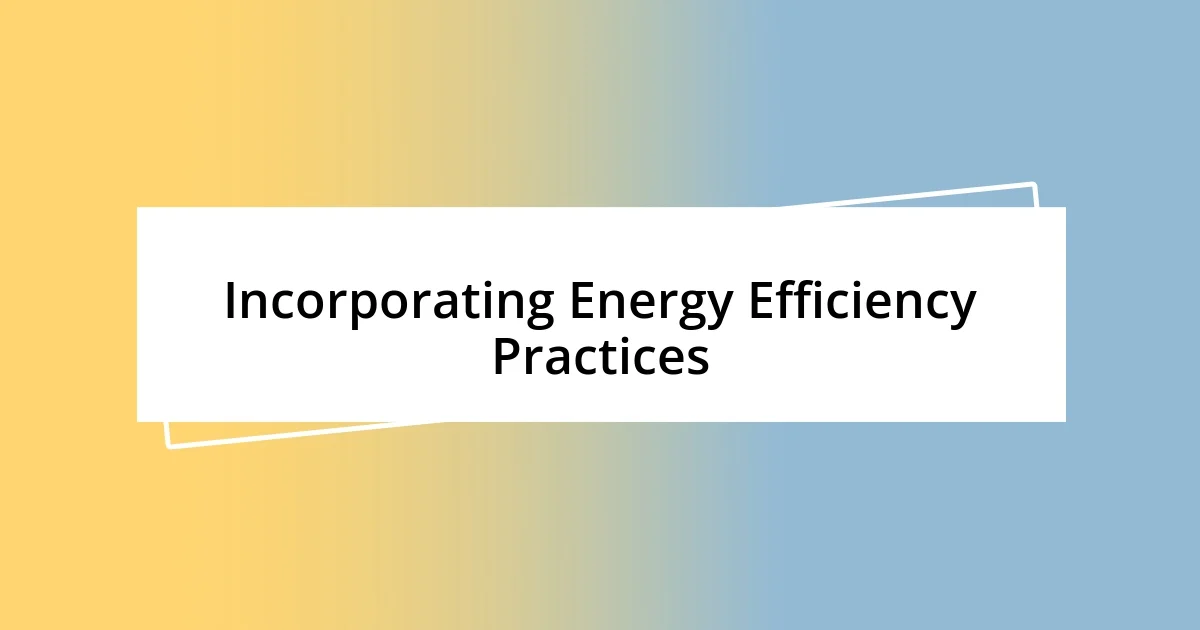
Incorporating Energy Efficiency Practices
Incorporating energy efficiency practices in my home has been an eye-opening experience. I recall the day I decided to switch to LED light bulbs. The change was simple, yet I was amazed at the difference it made—not only did the warm glow instantly brighten my rooms, but my electricity bill dropped significantly. Have you ever felt that rush of satisfaction from a small change leading to big results? It motivated me to explore even more ways to be energy efficient.
One of my proudest achievements was upgrading my old appliances to Energy Star-rated models. Initially, I hesitated due to the cost, but the long-term savings have been worth every penny. I remember the first time I used my energy-efficient washer—it was quieter and more effective than my previous one. Seeing the water and electricity meters reflect the reduced usage brought a grin to my face. It’s a reminder that investing in efficiency can pay off in multiple ways. Have you thought about how your own appliances could contribute to sustainability?
Additionally, I’ve taken steps to improve insulation in my home. I still laugh when I think about the winter I spent bundled up due to drafty windows. After sealing and adding weather stripping, my space felt cozy and inviting. Not only did it enhance my comfort, but also cut down on heating costs. Have you ever wondered how much you could save just by paying attention to those little leaks? Addressing these issues has connected me to the concept that every bit counts in our collective strides toward sustainability.
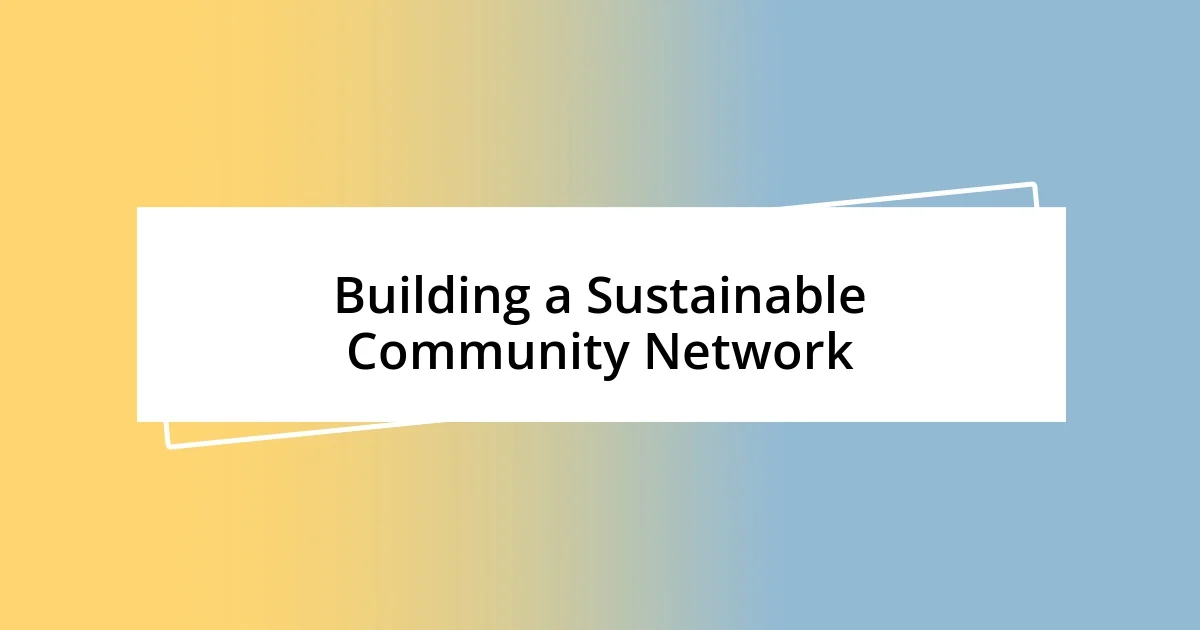
Building a Sustainable Community Network
Building a sustainable community network begins with genuine relationships and shared values. I remember the first community garden meeting I attended; the excitement in the room inspired me. Everyone had different backgrounds and reasons for being there, but a common goal united us: to cultivate not just food, but a strong, sustainable community. Engaging with neighbors over gardening tips and harvest recipes fostered a sense of belonging that I hadn’t felt before.
During those meetings, we exchanged ideas on how to reduce waste collectively. One resident shared a powerful story about her composting journey, discussing how it transformed her gardening results. Listening to her enthusiasm made me realize the ripple effect these conversations could have. Have you ever noticed how learning from one another can ignite positive change? I’ve seen firsthand how practical workshops on composting can empower people to take small steps towards sustainability while forming lasting friendships.
Not long after, our group organized a local sustainability fair, showcasing our community’s projects and initiatives. The energy was contagious, as families learned about eco-friendly practices in various booths. It felt incredible to witness neighbors coming together, fueled by a desire for a better environment and a shared commitment to support one another. Have you ever felt the thrill of collaboration? That day solidified my belief that building a sustainable community network is not just beneficial; it’s essential for creating a brighter, greener future for us all.












